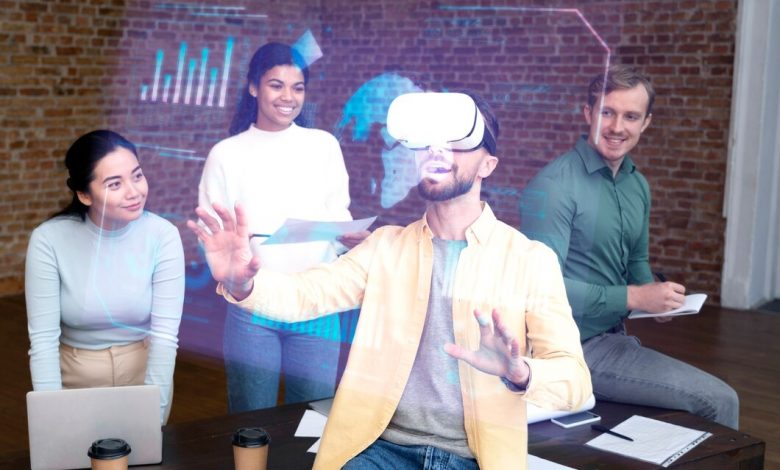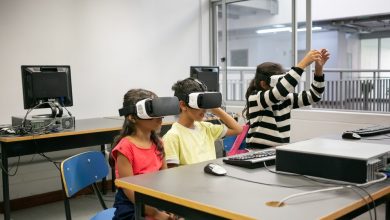The Role of Augmented Reality in Shaping the Future of Tech

Augmented Reality (AR) is no longer a concept from science fiction; it has become an integral part of our rapidly advancing technological landscape. In this article, we will delve into the evolution, applications, and the profound impact of AR on various industries, ultimately exploring its pivotal role in shaping the future of technology.
Introduction to Augmented Reality (AR)
Definition and Brief History
Augmented Reality refers to the integration of digital information with the user’s environment in real-time. Unlike Virtual Reality (VR), which immerses users in a completely virtual world, AR enhances the real world by overlaying digital elements. The roots of AR can be traced back to the 1960s, with significant advancements in recent decades.
AR vs. Virtual Reality (VR)
Before delving deeper, it’s crucial to distinguish between AR and VR. While VR creates a simulated environment, AR supplements the existing reality. Both technologies offer unique experiences, but AR, with its real-world integration, has gained substantial traction in various fields.
Evolution of Augmented Reality
Early Applications
AR’s journey began with rudimentary applications, primarily in the military and industrial sectors. Early adopters utilized AR for training simulations and enhancing situational awareness. However, the technology has come a long way since then.
Technological Advancements
The evolution of AR has been fueled by remarkable technological advancements. Smaller and more powerful hardware, coupled with sophisticated software, has paved the way for AR’s widespread adoption. Today, AR is accessible through smartphones, tablets, smart glasses, and other wearable devices.
Key Components of Augmented Reality
Hardware and Devices
AR hardware includes a diverse range of devices, from smartphones with AR capabilities to specialized smart glasses like Microsoft HoloLens. The development of lightweight and ergonomic AR devices has contributed significantly to the technology’s integration into daily life.
Software and Applications
The software side of AR encompasses a myriad of applications designed for different purposes. From AR-enhanced navigation apps to interactive educational tools, the software plays a crucial role in delivering seamless and engaging AR experiences.
Applications in Various Industries
Healthcare
In the healthcare sector, AR is revolutionizing surgical procedures through virtual overlays that provide real-time information to surgeons. Additionally, AR applications aid in patient care by offering innovative diagnostic tools and treatment plans.
Education
AR has transformed traditional classrooms into interactive learning environments. Students can explore historical events, dissect virtual organisms, and engage in immersive educational experiences, enhancing retention and understanding.
Gaming
The gaming industry has witnessed a paradigm shift with the integration of AR. Augmented reality games, such as Pokémon Go, have captivated audiences worldwide, blending virtual elements with the real world.
Retail
Augmented reality has redefined the retail experience by enabling virtual try-on experiences. Customers can visualize products in their real-world environment before making a purchase, enhancing confidence in online shopping.
Impact on User Experience
Immersive Interactions
One of the key strengths of AR lies in its ability to create immersive interactions. Whether it’s exploring historical landmarks through an AR app or participating in virtual treasure hunts, users are drawn into engaging experiences that blur the lines between the digital and physical realms.
Personalization
AR allows for personalized experiences tailored to individual preferences. From customized marketing content to personalized educational modules, AR adapts to the user’s needs, enhancing overall satisfaction.
Augmented Reality in Business
Marketing and Advertising
In the realm of marketing, AR opens new avenues for interactive advertising campaigns. Brands can create AR experiences that allow consumers to interact with products virtually, fostering a deeper connection and engagement.
Training and Development
Businesses are increasingly leveraging AR for employee training and development. From virtual simulations of real-world scenarios to hands-on training using AR applications, the technology enhances learning outcomes in a corporate setting.
Challenges and Concerns
Privacy Issues
As AR becomes more pervasive, concerns about privacy and data security have emerged. The collection and utilization of real-world data raise ethical questions that need careful consideration to ensure responsible implementation.
Technical Limitations
Despite advancements, AR still faces technical limitations, including battery life, device processing power, and the need for robust connectivity. Overcoming these challenges is crucial for the seamless integration of AR into various domains.
Future Trends in Augmented Reality
Integration with Artificial Intelligence (AI)
The synergy between AR and AI holds immense potential. The integration of AI algorithms can enhance AR applications, providing users with more intelligent and context-aware experiences.
Wearable AR Devices
The future of AR is closely tied to the development of wearable devices. As technology advances, we can anticipate the emergence of lightweight and stylish AR glasses that seamlessly integrate into our daily lives.
The Educational Landscape Transformed
AR in Classrooms
The traditional chalk-and-board approach is evolving with AR in classrooms. Teachers can use AR to create interactive lessons, making learning more engaging and dynamic for students.
Skill Development
AR not only imparts knowledge but also contributes to skill development. From practical skills like medical procedures to technical skills in various industries, AR serves as a valuable tool for honing abilities.
Healthcare Revolutionized
Surgical Procedures
In the healthcare sector, AR is not confined to diagnostics; it’s transforming surgical procedures. Surgeons can access real-time information and guidance through AR overlays, leading to more precise and efficient surgeries.
Patient Care
Beyond the operating room, AR applications enhance patient care. From virtual therapy sessions to personalized treatment plans, AR contributes to a holistic approach to healthcare.
Entertainment and Gaming Revolution
Enhanced Gaming Experiences
Gaming has transcended traditional boundaries with AR. The combination of




